Age of Empires IV
- Information
- Trailer
Year: 2021
Developer: Relic Entertainment
Genre: Real-time strategy
Duration played: 24 hours (completed campaign)


Real time for eternity
Is there a better feeling for a gamer than finishing a game and thinking: “That was good. I have nothing to complain about, a well-rounded experience.” I haven't had that feeling for a long time, at least not in this form. And then also with a relatively new game. Day-one patches and the games-as-a-service mentality have burned my greedy fingers too often for me to buy a title around the time of its actual release. Now this game came out in October, so I can probably forget about the title 'early adopter'. But as I said, for me a purchase three months after release is comparatively early.
Age of Empires IV is everything strategy game fans could wish for. It is beginner-friendly enough for newcomers to have fun, complex enough to keep tinkerers and pros from getting bored and versatile enough to appeal to every type of player. I'm probably somewhere in the middle, which is why I approached the game without any real expectations. In fact, it was more curiosity after I had seen several videos about it and I told myself that I kind of wanted to play it. A nice feeling, which is even nicer when it's rewarded.
A quick disclaimer: I've only played the campaign so far, so I haven't seen everything in the game yet. I'll explain why that is later. But for now, I can recommend Age of Empires IV without reservation. That's the end of the review, but I'd like to explain a little more about where my enthusiasm comes from. So if you're interested and have a few minutes to spare, I'll now move on to the actual review.
Age of Ehm-what?
For anyone who has never heard of Age of Empires , here is a brief introduction. The AoE-series is one of the oldest strategy game series and, if my memories don't deceive me, my first contact with the genre itself. As the name suggests, it is about two things: times and empires. What is meant is that we lead a people through different eras and try to defeat our enemies in the process. The principle is nothing unique and can also be found in games such as Empire Earth or the Total-War-series.
While we are still dealing with club wielding soldiers and militias in Antiquity, the Imperial Age is already getting down to business with gunpowder units. But don't worry, the Stone Age and Antiquity were only represented in the first game from 1997, the successors all begin in the 'Dark Ages', the early Middle Ages, and extend into the Renaissance. To advance our civilization, we collect four resources (food, wood, stone and gold) and build various buildings that give us advantages: Houses to allow us to command more units, stables to train cavalry, etc. And that's basically it, or as they used to say at game night: “The rest is explained as you play.”
So simple and yet so complex. This is largely due to the many units that help us on our way to victory. Those familiar with the games will immediately feel at home, the subdivisions of infantry, artillery, cavalry and archers as well as the familiar rock-paper-scissors principle have been adopted and only minimally adapted. This is a good thing, because it worked excellently back then and still does today. In addition, there are once again countless technologies that strengthen different parts of our military or our economy and leave plenty of room for experimentation and optimization.
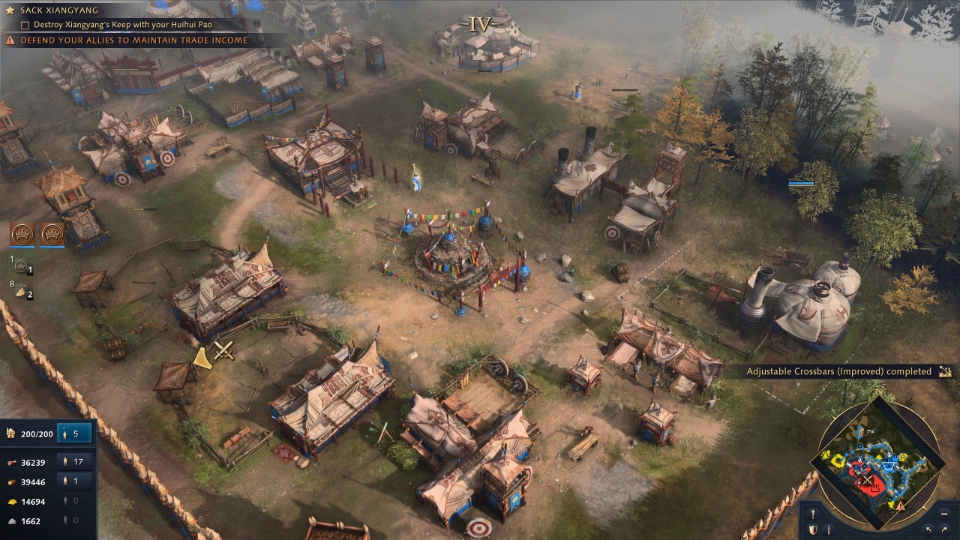
Old engine, new paint job
Where Age of Empires IV of Empires IV differs from its predecessors, however, are the nations. This time there are only eight of them: the Chinese, the Holy Roman Empire, the English, the Mongols, the French, the Abbasid Dynasty, the Delhi Sultanate and the Rus. As with their predecessors, these factions naturally have 2-3 special units and certain advantages that distinguish them from their counterparts. For example, the villagers of the English can cultivate fields near mills more quickly and defend themselves with bows, while the Holy Roman Empire can quickly repair its buildings with emergency repairs. The Mongols, on the other hand, do not build any fields at all, but instead breed sheep and, as a nomadic people, can simply pack up all their buildings and re-erect them somewhere else - neat!
Unlike for example in Age of Empires II , each faction also has a kind of mini-game system, which is sometimes more, sometimes less extensive. For example, the Rus receive gold for killing wild animals and increase their bounty counter. When these reach certain marks, perks are automatically unlocked that speed up the gathering of food and allow hunting lodges near forests to generate gold. The Mongols, on the other hand, cannot mine stone, but build an 'Ovoo', which mines stone slowly, but automatically. This means we can't build anything at first - nomads rarely use stone for their constructions - but we can improve research and train units more quickly in buildings within the ovoo's sphere of influence. The Chinese, on the other hand, have tax collectors that boost buildings and their output.
And then there are landmarks, which we need to ascend to the new age and where we always have to choose between two unique buildings with different advantages. Veterans will probably remember this system from Age of Empires III, where you had to choose between two rulers to advance. However, the fact that the landmarks now appear in the game not only brings gameplay advantages, for example when the British can produce their dreaded longbowmen 100% faster from the Council Hall. They are also a new victory condition that spices up the game in multiplayer mode - presumably, I haven't tried it yet. If all landmarks are destroyed, the opponent is out. Gone are the days of searching for the last villager on the map. Oh joy!
In addition to the relics, the holy cities from the first Age of Empires have also found their way back. They generate gold after being conquered by a priest and the player who holds all of them on the map long enough also wins the round. However, I would like to say less about these game mechanics because I simply haven't tried them out. But, and this should be clear by now, they are a welcome addition to give the game more variability and present players with important options - and that's never a bad thing.
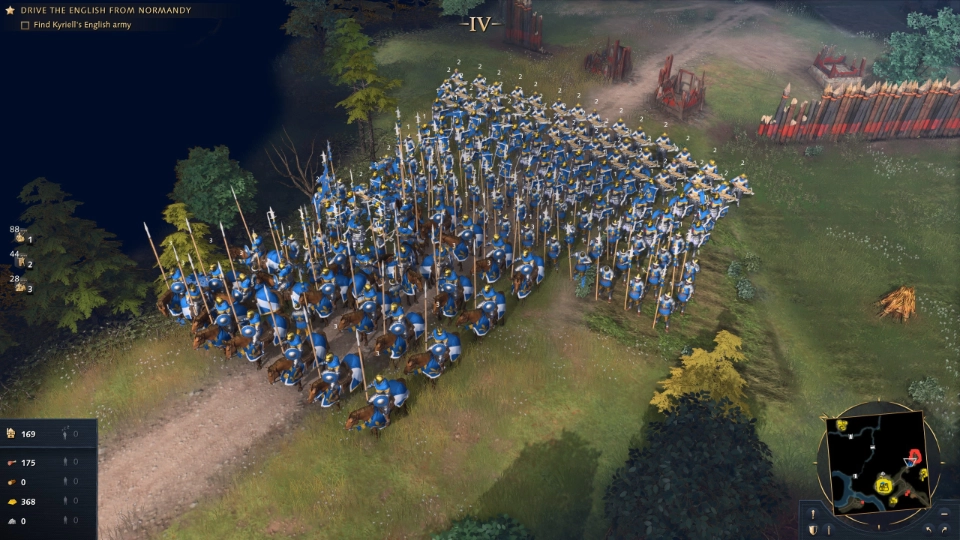

A history lesson instead of a campaign
Be that as it may, let me now talk less about things that I cannot judge and more about those that I have experienced first-hand - as the young people would say. The game mechanics work and are fun, at least those of the British, French, Mongols and Rus. Because there is only a campaign for these four nations - leaving out a short section with the Chinese. Compared to its predecessors, this, together with the number of playable factions, is initially a step backwards. The fact that it doesn't feel like this is due to the great staging with which the historical scenarios are established. It feels as if the BBC had been asked to fulfill the game's educational mission, as each campaign is framed by documentaries, short films, animations and so much attention to detail that the actual missions seem more like links in a documentary series. This may not appeal to everyone, but I found it incredibly exciting and more than fair justification for the 'small' number of missions due to the production effort.
In general, however, the missions were not really a highlight, but rather served as lengthy tutorials for the individual peoples. Unfortunately, the AI of the enemies was also very script-dependent and not really a challenge even on the advanced difficulty level. To make matters worse, there is no fixed order for the individual campaigns, which is why we always get the same introduction at the beginning on how to play Age of Empires IV . As the nations differ in their playing styles, this is fine, but it's a shame that some aspects are completely omitted as a result, and after completing the story and with 24 hours of game time on the clock, I haven't handled water units once. An entire aspect of the game simply doesn't take place alongside the other nations in the campaign.
However, these points of criticism probably don't interest most players anyway, who prefer to throw themselves straight into the multiplayer brawl. I, however, come from a time when I played Battlefields and Call of Dutys because of the single-player part - which is ironic when you consider that Battlefield was initially a pure multiplayer game and only got a campaign with the third game. I digress.
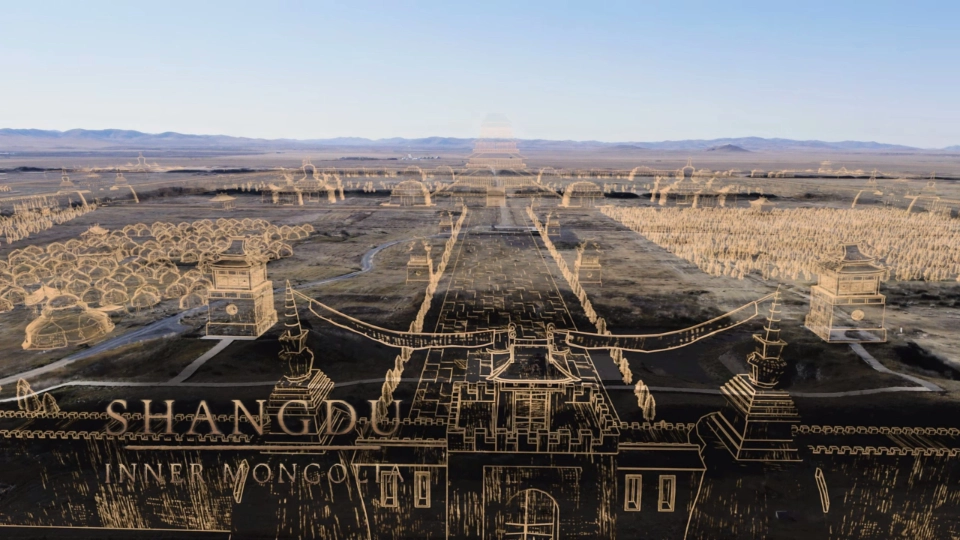
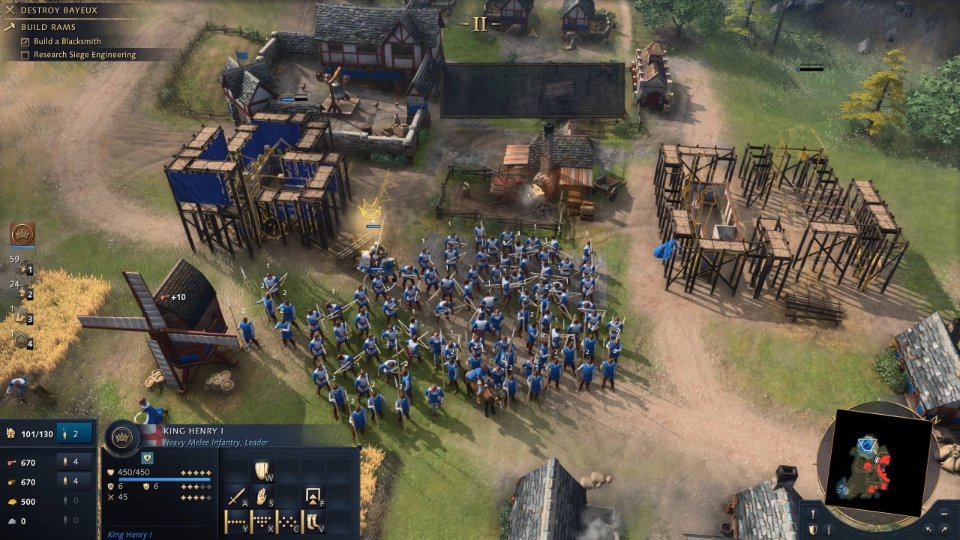
Masterful medieval atmosphere
In general, Age of Empires IV impressed me not only with its well thought-out gameplay enhancements, but also with its overall presentation. The atmosphere in this medieval fan-fest is outstanding. The graphics may seem simple at first glance and do not look exceptional in relation to other games. Nevertheless, compared to other real-time strategy games, they are impressive and above all ensure that we have a smooth gaming experience. I personally like the art style very much, for example the implied contours and blueprint-like depiction of undiscovered territory had already turned me on in Sid Meier’s Civilization VI and Total War: Rome 2 . And even design decisions that were initially viewed critically, such as the outlines of people carrying out construction work in fast motion, didn't bother me in any way.
The fact that the nations are visually pleasantly different and not roughly divided into Western, Eastern and Far Eastern building styles as in Age of Empires II also gives the whole thing a flair and brings back the old scurrying feeling of the Settlers-series, where you simply looked at your small city in peace. Here you immediately recognize whether you are in an imperial city of the Rus or a track of the Mongols. And last but not least: you can hear it too! Both the ambient sounds are great, for example when one of our scouts spots an enemy and alerts us with a loud whistle, as well as the loud war cries with which the troops throw themselves into battle.
No, my personal highlight of the AoE-series was not neglected in part 4: the unit quotes. I just love it when my villagers comment on my orders in early medieval English - or at least an attempted reconstruction of it. Sayings from the 2 game such as “Das ich soll!”, “Bis wahr”, “Strittet” or “Ik willen” are still in my memory today. And now they even made sure that the language evolved as civilization progressed. Where before you could only hear some incomprehensible mumbling, in the imperial era you can almost listen to the modern version. This is great and shows not only the attention to detail, but also the linguistic development when I, as a German, can almost understand the British before the vowel shift.
Of course, I don't want to ignore the soundtrack at this point, which also fits very nicely into the overall picture and which I will certainly discuss in more detail elsewhere. As things stand, I have nothing to criticize about the work done by Dynamedion studio. As with the latest addition to the Civilizations-series, the music continues to evolve, becoming more complex and sophisticated. A distinction is also made between peace and war tracks, which wonderfully emphasize the atmosphere of the game.

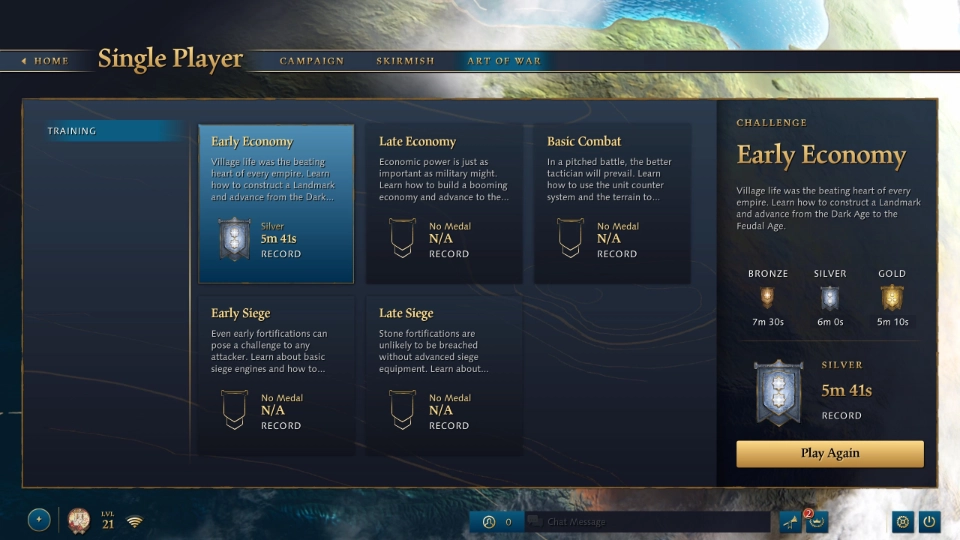
Summary
Let's come to the final conclusion: Age of Empires IV is a great game, and not only that: it's also a very good Age of Empires . I think you can put aside your initial skepticism and the “everything used to be better” attitude without hesitation - at least for this part - and find a game that stays true to its ancestors, but improves them in exactly the right places. Little things, such as the fact that fields no longer have to be renewed manually or the addition of the “Art of War” scenarios, with which beginners can practise core aspects of the game, are welcome additions. And negative aspects, such as the smaller playable extent of the campaign, are well compensated for by the scope of the content.
It is to be hoped that this course will be maintained in the development of future content, that new factions and more exciting campaigns will follow. But unlike many other modern games, Age of Empires IV is not just the foundation on which future titles can build. It is a finished house, ready to move into and free of charge. A larger garden would be nice, perhaps an additional wing will be added. Until then, we can move in here without hesitation and feel at home. A bit like it used to be.




2 Comments
Muh hadin of the muhty Empire
Muh, Muh, Muh
Ok, ich Kauf es mir